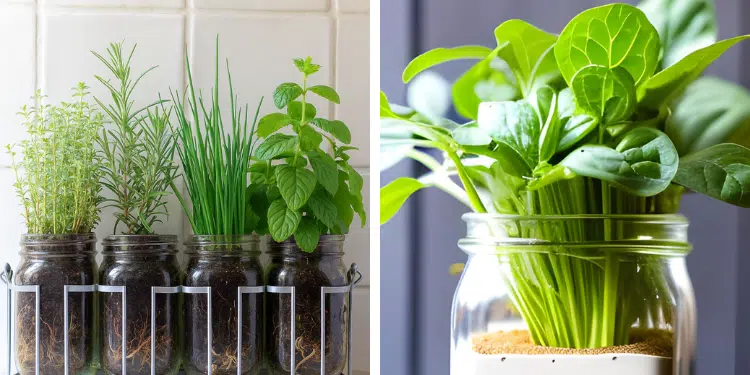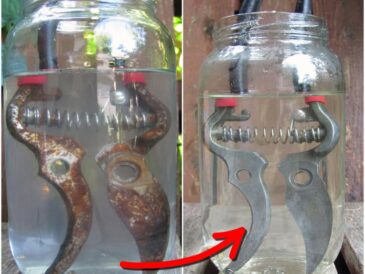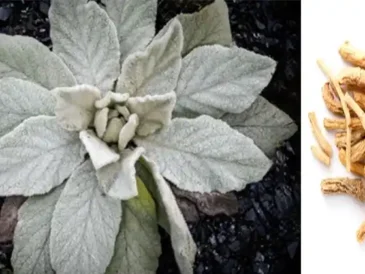With just a few mason jars, some potting mix, water, and sunlight, you can grow a surprising variety of fresh, edible plants right on your windowsill, balcony, or kitchen counter.
Mason jars don’t just look charming – they also let you observe root growth, control watering easily, and make use of limited space.
Why Grow Food in Mason Jars?
Before we get to the plants, let’s understand why mason jars work so well for small-scale growing.
1. Space Efficiency
You can line jars along a sunny windowsill, kitchen shelf, or balcony ledge. They take up minimal room but still allow roots to grow freely for smaller herbs and vegetables.
2. Control Over Growing Conditions
You can easily manage moisture, light, and nutrients. Transparent glass makes it simple to see when the soil is drying out or when roots need more room.
3. Low Cost, High Reward
No need for expensive planters – most homes already have jars. You can reuse jam jars, pickle jars, or canning jars for an eco-friendly project.
4. Perfect for Beginners
If you’re new to gardening, jar growing gives you a gentle introduction. You’ll learn how plants respond to light and water without worrying about pests, weeds, or large soil beds.
5. Aesthetic and Functional
Mason jars bring rustic charm to your home. Fresh herbs or microgreens in glass jars make beautiful, living kitchen decor – and they’re edible too.
Getting Started: The Basics of Growing in Mason Jars
Before planting, you’ll need a few essentials to set up your jars for success.
Choose the Right Jar Size
- Small jars (8 oz–12 oz): Best for microgreens, green onions, or sprouts.
- Medium jars (16 oz–24 oz): Great for herbs like basil, mint, or cilantro.
- Large jars (32 oz+): Suitable for leafy greens, strawberries, or dwarf tomatoes.
Create Drainage (The Most Important Step)
Unlike regular pots, mason jars don’t have holes at the bottom, so drainage is key.
Here’s how to do it:
- Add a 1–2 inch layer of pebbles, gravel, or perlite at the bottom of each jar.
- This allows excess water to collect without suffocating roots.
- Optionally, place a piece of mesh or coffee filter above the gravel before adding soil.
Use the Right Soil
Go for light, well-draining potting mix. Avoid heavy garden soil.
For herbs and leafy greens, a mix of:
- 2 parts potting mix
- 1 part perlite or vermiculite
- 1 part compost
Light and Location
Most edible plants need 4–6 hours of sunlight daily. South-facing windowsills are ideal. If natural light is limited, consider a small LED grow light.
Watering and Feeding
Jar plants dry out more slowly because there’s no drainage hole, so water sparingly:
- Check moisture by touching the soil surface.
- Water only when the top inch feels dry.
- Fertilize lightly every 2–4 weeks using liquid organic fertilizer or compost tea.
10 Foods You Can Grow in Mason Jars
Now, let’s dig into the exciting part – the plants themselves. These 10 foods are easy, rewarding, and thrive in small glass containers.
1. Green Onions (Scallions)
Why They’re Perfect for Jars
Green onions are one of the easiest plants to regrow endlessly from kitchen scraps. All you need are leftover root ends from store-bought onions.
How to Grow
- Cut off the white root base, leaving about 1–2 inches of stem.
- Place the roots in a jar with just enough water to cover them.
- Set near a sunny window and change the water every few days.
- New green shoots will emerge in 5–7 days.
Once they grow a few inches, you can either harvest or transfer them to a jar filled with potting soil for longer growth.
Harvest
Trim the greens when they’re 6–8 inches tall. They’ll regrow repeatedly as long as roots remain healthy.
2. Basil
Why It Thrives in Jars
Basil loves warm, sunny windowsills and doesn’t require deep soil. Its roots stay compact, making it an ideal jar herb.
How to Grow
- Fill a 16–20 oz jar with moist potting mix.
- Plant basil seeds ¼ inch deep, or transplant small seedlings.
- Place the jar in a warm, sunny spot (at least 6 hours of light).
- Keep the soil consistently moist but not soggy.
Pro Tip
Pinch off flower buds as soon as they appear to keep the plant producing leaves longer.
Harvest
Begin snipping leaves once the plant reaches 6 inches tall. Always harvest from the top to encourage branching.
3. Lettuce
Why It Works
Lettuce varieties like Butterhead, Oakleaf, and Looseleaf grow shallow roots, perfect for jar cultivation.
How to Grow
- Choose a wide-mouth jar (at least 24–32 oz).
- Fill halfway with potting soil mixed with compost.
- Scatter seeds evenly on top and lightly cover with soil.
- Mist gently to keep the soil damp.
- Place near bright, indirect sunlight.
Lettuce prefers cooler conditions (60–70°F), so avoid placing jars near radiators or direct heat sources.
Harvest
Snip outer leaves as they mature, leaving inner ones to regrow. You can harvest fresh salads for weeks.
4. Mint
Why It’s Ideal
Mint is hardy, fast-growing, and forgiving – even if you forget to water occasionally. It also naturally repels insects and gives your kitchen a refreshing scent.
How to Grow
- Fill a 16–20 oz jar with soil.
- Plant mint cuttings or root divisions about 2 inches deep.
- Keep soil slightly moist and provide bright, indirect light.
Pro Tip
Don’t mix different mint varieties in one jar – they’ll compete and cross flavors.
Harvest
Pick leaves regularly to encourage new growth. Use them fresh in tea, desserts, or drinks.
5. Spinach
Why It’s a Smart Choice
Spinach grows quickly and thrives in cool temperatures. It doesn’t need deep roots, making it perfect for jars.
How to Grow
- Use a large jar (1 quart or more).
- Fill with loose, fertile soil rich in compost.
- Sow 2–3 seeds per jar, ½ inch deep.
- Keep in a bright but cool place (60°F is ideal).
Watering Tip
Water when the top inch of soil feels dry. Avoid overwatering – spinach dislikes soggy roots.
Harvest
Cut outer leaves once they reach 3–4 inches long. New leaves will continue to grow from the center.
6. Garlic Greens
Why They’re Unique
Instead of growing full garlic bulbs (which require deep soil), you can grow garlic greens – tender shoots with a mild garlic flavor.
How to Grow
- Fill a jar halfway with potting mix.
- Push 3–4 garlic cloves (unpeeled) into the soil, pointy side up.
- Water lightly and place in sunlight.
Growth Timeline
Shoots appear within a week and reach full height in 10–14 days.
Harvest
Snip the green shoots when they’re 6–8 inches tall. Each clove produces one round of greens.
7. Strawberries
Why It’s Possible
Yes, strawberries can grow in mason jars – especially everbearing or alpine varieties that stay compact and produce small fruits.
How to Grow
- Choose a large jar (32 oz or bigger).
- Add a drainage layer, then fill with rich potting soil.
- Plant one strawberry crown with roots spread out.
- Keep in bright sunlight (6+ hours per day).
- Water consistently but avoid soggy soil.
Pro Tip
Rotate jars occasionally so all sides receive light evenly.
Harvest
Fruits typically appear after 8–10 weeks. Pick them as soon as they turn red and aromatic.
8. Cilantro (Coriander)
TO CONTUNUE READING THE ARTICL PLEASE SEE PAGE 2 .




